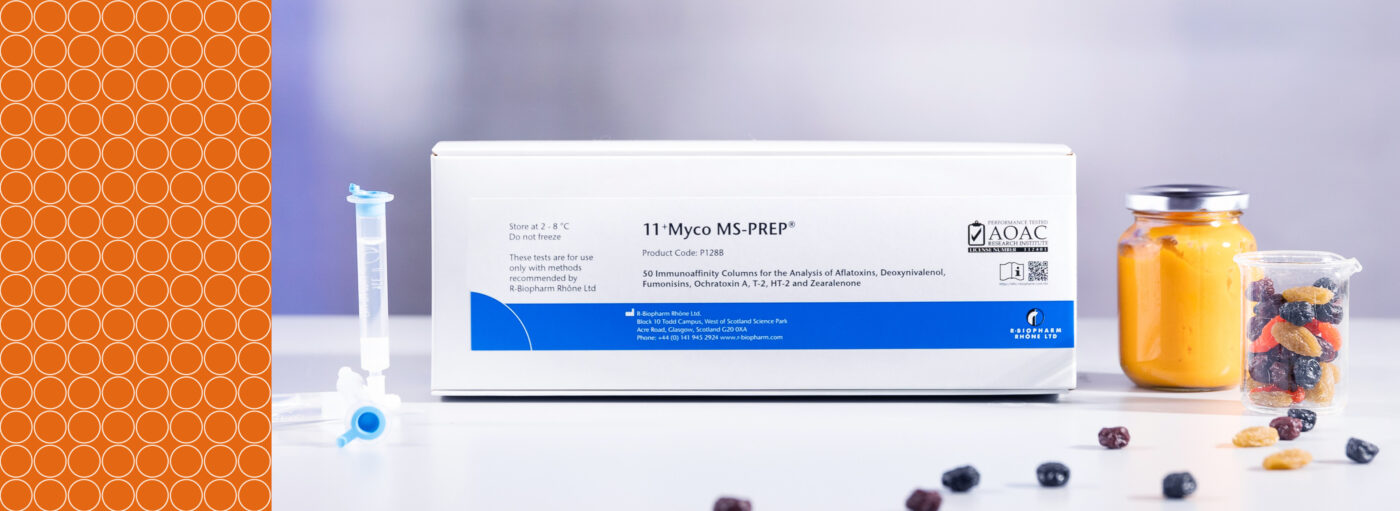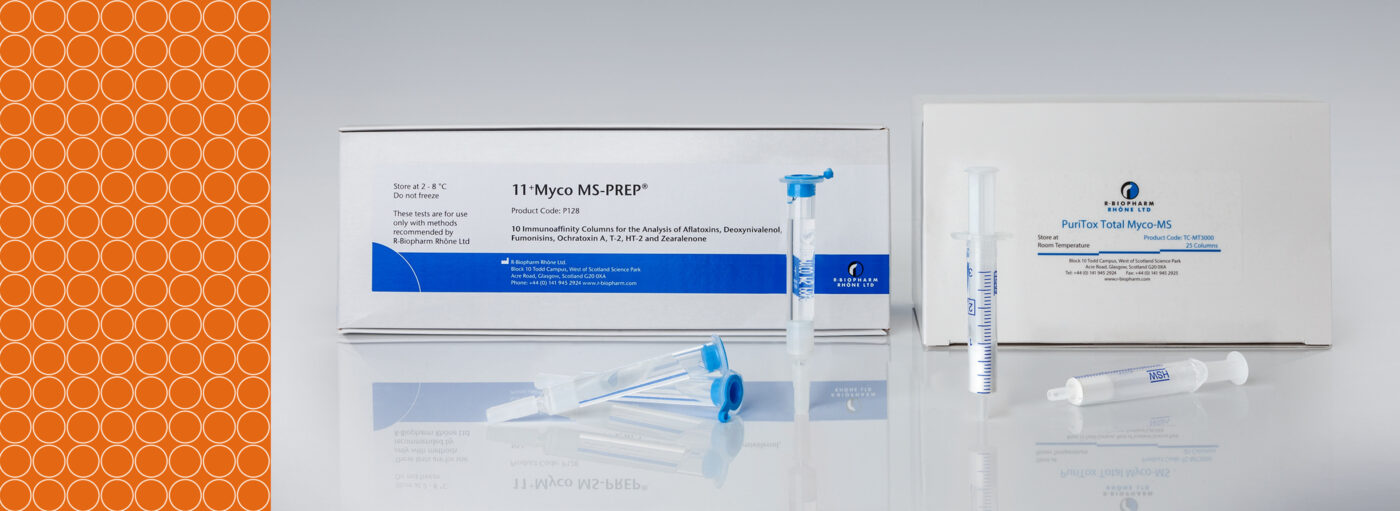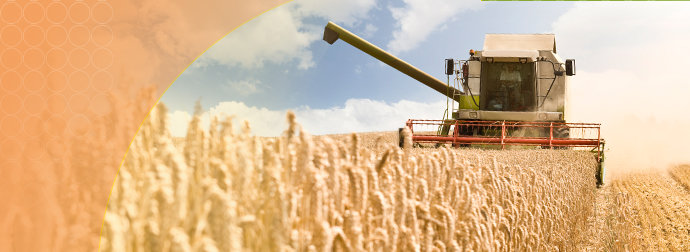
DON (Vomitoxin)
Reliable tests for the detection of deoxynivalenol in food
- Home
- /
- Analytes
- /
- Mycotoxins
- /
- DON (Vomitoxin)
Deoxynivalenol (DON, Vomitoxin): Monitoring and Analysis
Importance of monitoring deoxynivalenol (DON)
Deoxynivalenol (DON), also known as Vomitoxin, is a trichothecene mycotoxin produced by fungi of the genus Fusarium. DON frequently contaminates various plant products, particularly cereal crops such as wheat, corn, barley, oats, and rye. Due to its high cytotoxic and immunosuppressive properties, DON poses significant health risks to both humans and animals.
Common sources and effects of DON
More than 150 trichothecenes are known, with deoxynivalenol, 3-acetyl-deoxynivalenol, and 15-acetyl-deoxynivalenol being the most frequently occurring toxins in Europe and North America. The toxin concentrations found in wheat, corn, and rice are often in the ppm range.
In animals, DON-contaminated feed has led to feed refusal, vomiting, diarrhea, and growth depression. In humans, food poisoning with DON has caused symptoms such as abdominal pain, dizziness, headache, throat irritation, nausea, vomiting, diarrhea, and blood loss in stools. DON is a very stable compound that does not degrade at high temperatures during storage, milling, processing, and cooking of food.
Regulatory compliance and consumer protection
The U.S. FDA has set advisory levels for DON, stipulating 1 ppm for finished wheat products intended for human consumption and 5 ppm for grain and grain by-products for swine and other animals. To ensure safety, regular analysis and monitoring of DON levels in food and feed products are essential.
Key benefits of DON monitoring
- Consumer protection: Ensures that food products are safe for human consumption by detecting and quantifying DON contamination.
- Animal health: Protects livestock from the adverse effects of DON-contaminated feed, improving animal welfare and productivity.
- Regulatory compliance: Helps manufacturers comply with U.S. FDA advisory levels and other international food safety regulations.
- Quality assurance: Maintains the integrity and safety of food and feed products by preventing the distribution of contaminated items.
- Advanced detection methods: Utilizes reliable and efficient analytical platforms for the accurate monitoring of DON levels in various plant products.
Conclusion
Monitoring deoxynivalenol (DON) is crucial for protecting human and animal health, ensuring regulatory compliance, and maintaining food and feed quality. By employing advanced detection methods, manufacturers can accurately identify and quantify DON contamination, ensuring the safety of their products. This proactive approach supports robust quality control processes, upholds food safety standards, and fosters consumer trust in food and feed products.
Product portfolio
| Product | Description | No. of tests/amount | Art. No. |
|---|---|---|---|
| RIDASCREEN® DON |
RIDASCREEN® DON is a competitive enzyme immunoassay for the quantitative analysis of DON in cereals, malt, feed, beer and wort. Read more |
Microtiter plate with 96 wells (12 strips with 8 wells each) | R5906 |
| RIDASCREEN®FAST DON SC |
RIDASCREEN®FAST DON SC is a competitive enzyme immunoassay for the quantitative determination of DON in cereals, malt and feed with a sinlge control standard curve. Read more |
Microtiter plate with 48 wells (6 strips with 8 wells each). | R5905 |
| RIDASCREEN®FAST DON |
RIDASCREEN®FAST DON is a competitive enzyme immunoassay for the quantitative analysis of DON in cereals, malt and feed. Read more |
R5901: microtiter plate with 96 wells (12 strips with 8 removable wells each) R5902: microtiter plate with 48 wells (6 strips with 8 removable wells each) |
R5901 / R5902 |
| Product | Description | No. of tests/amount | Art. No. |
|---|---|---|---|
| RIDA®QUICK DON RQS ECO |
RIDA®QUICK DON RQS ECO is a quantitative immunochromatographic test with water extraction in a test strip format to determine DON in grains (wheat, corn, barley, oats). Results are evaluated with the RIDA®SMART APP software (Art. No. ZRSAM1000) and … Read more |
20 x test strips | R5911 |
| Product | Description | No. of tests/amount | Art. No. |
|---|---|---|---|
| QualiT Pure™ Multi-Ergot Alkaloid MS |
Solid phase clean-up column for the purification of multi-mycotoxins. Read more |
50 columns (syringe format) | TC-QP2100-50 |
| QualiT Pure™ Multi-Mycotoxin |
Solid phase clean-up column for the purification of multi-mycotoxins. Read more |
50 columns (syringe format) | TC-QP1000-50 |
| QualiT Pure™ Multi-tox MS |
Solid phase clean-up column for the purification of multi-mycotoxins. Read more |
50 columns (syringe format) | TC-QP1100-50 |
| DZT MS-PREP® |
DZT MS-PREP® immunoaffinity columns contain highly specific monoclonal antibodies directed against DON, zearalenone, T-2 and HT-2 toxin. The columns lead not only to a clean-up of the sample but also to a selective purification of the mycotoxins. … Read more |
RBRP73: 10 immunoaffinity columns (1 ml format), RBRP73B: 50 immunoaffinity columns (1 ml format) |
RBRP73 / RBRP73B |
| DONPREP® |
Immunoaffinity columns for use in conjunction with an HPLC or LC-MS/MS for detection of deoxynivalenol in a wide range of commodities. Read more |
10 columns (3 ml format) (RBRP50) 50 columns (3 ml format) (RBRP50B) |
RBRP50 / RBRP50B |






